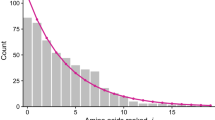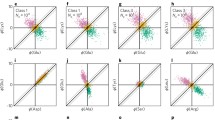Summary
We have obtained a revised estimate of the pattern of point mutation by considering more pseudogene sequences. Compared with our previous estimate, it agrees better with expectations based on the double-strand structure of DNA. The revised pattern, like the previous one, indicates that mutation occurs nonrandomly among the four nucleotides. In particular, the proportion of transitional mutations (59%) is almost twice as high as the value (33%) expected under random mutation. The same high proportion of transitions is observed in synonymous substitutions in genes. The proportion of transitional changes observed among electrophoretic variants of human hemoglobin is about the same as that predicted by the revised pattern of mutation. We also show that nonrandom mutation increases, by about 15%, the proportion of synonymous mutations due to single-nucleotide changes in the codon table, and increases, from 10% to 50%, the rate of synonymous mutation in the seven genes studied. However, nonrandom mutation reduces (by about 10%) the proportion of polar changes among nonsynonymous mutations in a gene. As far as single-nucleotide changes (in the codon table) are concerned, nonrandom mutation only slightly favors relatively conservative amino acid interchanges, and has virtually no effect on the proportions of radical changes and nonsense mutations.
Similar content being viewed by others
References
Anderson RD, Birren BW, Ganz T, Piletz JE, Herschman HR (1983) Molecular cloning of the rat metallothionein 1 (MT-1) mRNA sequence. DNA 2:15–22
Aquadro CF, Greenberg BD (1983) Human mitochondrial DNA variation and evolution: analysis of nucleotide sequences from seven individuals. Genetics 103:287–312
Beale D, Lehmann H (1965) Abnormal hemoglobins and the genetic code. Nature 207:259–261
Bothwell AL, Paskind MM, Reth M, Imanishi-Kari T, Rajewsky K, Baltimore D (1981) Heavy chain variable region contribution to the Npb family of antibodies: somatic mutation evident in a 2a variable region. Cell 24:625–637
Brown ADH, Marshall DR, Albrecht L (1975) Profiles of electrophoretic alleles in natural populations. Genet Res 25:145–153
Brown WM, Prager EM, Wang A, Wilson AC (1982) Mitochondrial DNA sequences of primates: tempo and mode of evolution. J Mol Evol 18:225–239
Cleary ML, Schon EA, Lingrel JB (1981) Two related pseudogenes are the result of a gene duplication in the goat β-globin locus. Cell 26:181–190
Cleveland DW, Lopata MA, MacDonald RJ, Cowan NJ, Rutter WJ, Kirschner MW (1980) Number and evolutionary conservation of α- and β-tubulin and cytoplasmic β- and γ-actin genes using specific cloned cDNA probes. Cell 20:95–105
Cohen JB, Effron K, Rechavi G, Ben-Neriah Y, Zadut R, Givol D (1982) Simple DNA sequences in homologous flanking regions near immunoglobulin VH genes: A role in gene interaction? Nucleic Acids Res 10:3353–3370
Coulondre C, Miller JH, Farabaugh PJ, Gilbert W (1978) Molecular basis of base substitution hotspots inEscherichia coli. Nature 274:775–780
Dayhoff MO, Eck RV, Park CM (1972) A model of evolutionary change in protein. In: Dayhoff MO (ed) Atlas of protein sequence and structure. National Biomedical Research Foundation, Silver Spring, Maryland, pp. 89–99
Doolittle RF (1979) Protein evolution. In: Neurath H, Hill RL (eds) The proteins. Academic Press, New York, pp 1–119
Dugaiczyk A, Law SW, Dennison OE (1982) Nucleotide sequence and the encoded amino acids of human serum albumin mRNA. Proc Natl Acad Sci USA 79:71–75
Fitch WM (1967) Evidence suggesting a nonrandom character to nucleotide replacements in naturally occurring mutations. J Mol Biol 26:499–507
Fowler RG, Degnen GE, Cox EC (1974) Mutational specificity of a conditionalEscherichia coli mutator,mut D5. Mol Gen Genet 133:179–191
Fresco JR, Broitman S, Lane A-E (1980) Base mispairing and nearest-neighbor effects in transition mutations. In: Alberts B (ed) Mechanistic studies of DNA replication and genetic recombination. Academic Press, New York, pp 753–768 (ICN-UCLA symposia on molecular and cellular biology, vol 19)
Glanville N, Durnam DM, Palmiter RD (1981) Structure of mouse metallothionein-I gene and its mRNA. Nature 292:267–269
Gojobori T, Li W-H, Graur D (1982) Patterns of nucleotide substitution in pseudogenes and functional genes. J Mol Evol 18:360–369
Grantham R (1974) Amino acid difference formula to help explain protein evolution. Science 185:862–864
Hagenbüchle O, Bovey R, Young RA (1980) Tissue-specific expression of mouse α-amylase genes: nucleotide sequence of isoenzyme mRNAs from pancreases and salivary gland. Cell 21:179–187
Hellman L, Patterson U, Engstrom A, Karlsson T, Bennich H (1982) Structure and evolution of the heavy chain from rat immunoglobulin E gene. Nucleic Acids Res 10:6041–6049
Hennighausen LG, Sippel AE (1982) Comparative sequence analysis of the mRNAs coding for mouse and rat whey acid protein. Nucleic Acids Res 10:3733–3744
Holmquist R (1976) Solution to a gene divergence problem under arbitrary stable nucleotide transition probabilities. J Mol Evol 8:337–349
Holmquist R, Cantor C, Jukes T (1972) Improved procedure for comparing homologous sequences in molecules of proteins and nucleic acids. J Mol Biol 64:145–161
Hunt LT, Sochard MR, Dayhoff MO (1972) Mutations in human genes. In: Dayhoff MO (ed) Atlas of protein sequence and structure. National Biomedical Research Foundation, Silver Spring, Maryland, pp 67–87
Jagodzinski LL, Sargent TD, Yang M, Clackin C, Bonner J (1981) Sequence homology between RNAs encoding rat α-fetoprotein and rat serum albumin. Proc Natl Acad Sci USA 78:3521–3525
Jukes TH (1980) Silent nucleotide substitutions and the molecular evolutionary clock. Science 210:973–978
Kimura M (1977) Preponderance of synonymous changes as evidence for the neutral theory of molecular evolution. Nature 267:275–276
Konkel DA, Tilghman SM, Leder P (1978) The sequence of the chromosomal mouse β-globin major gene: homologies in capping, splicing, and poly(A) sites. Cell 17:1125–1132
Kreitman M (1983) Nucleotide polymorphism at the alcohol dehydrogenase locus ofDrosophila melanogaster. Nature 304:412–417
Kretschmer PJ, Coon HC, Davis A, Harrison M, Nienhuis AW (1981) Hemoglobin switching in sheep: isolation of the fetal γ-globin gene and demonstration that the fetal γ- and adult βA-globin genes lie within eight kilobase segments of homologous DNA. J. Biol Chem 256:1975–1982
Lacy E, Maniatis T (1980) The nucleotide sequence of a rabbit β-globin pseudogene. Cell 21:545–553
Law SW, Dugaiczyk A (1981) Homology between the primary structure of α-fetoprotein, deduced from a complete cDNA sequence, and serum albumin. Nature 291:201–205
Lawn RM, Efstratiadis A, O'Connel C, Maniatis T (1980) The nucleotide sequence of the human β-globin gene. Cell 21:647–651
Lee MG-S, Lewis SA, Wilde CD, Cowan NJ (1983) Evolutionary history of a multigene family: an express human β-tubulin gene and three processed pseudogenes. Cell 33:477–487
Lehmann H, Kynoch PAM (1976) Human haemoglobin variants and their characteristics. North-Holland, Amsterdam
Lemischka I, Sharp PA (1982) The sequences of an expressed rat α-tubulin gene and a pseudogene with an inserted repetitive element. Nature 300:330–335
Li W-H, Gojobori T (1983) Rapid evolution of goat and sheep globin genes following gene duplication. Mol Biol Evol 1:94–108
Liebhaker SA, Goosens M, Kan YW (1981) Homology and concerted evolution at the α1 and α2 loci of human α globin. Nature 270:26–29
Liu FT, Albrandt K, Sutcliffe JG, Katz DH (1982) Cloning and nucleotide sequence of mouse immunoglobulin ∈ chain cDNA. Proc Natl Acad Sci USA 79:7852–7856
MacDonald RJ, Crerar MM, Swain WF, Pictet RL, Thomas G, Rutter WJ (1980) Structure of a family of rat amylase genes. Nature 287:117–122
Max EE, Battey J, Ney R, Kirsch IR, Leder P (1982) Duplication and deletion in the human immunoglobulin ∈ genes. Cell 29:691–699
Michelson AM, Orkin SH (1980) The 3′ untranslated regions of the duplicated human α-globin genes are unexpectedly divergent. Cell 22:371–377
Miyata T, Yasunaga T, Nishida T (1980) Nucleotide sequence divergence and functional constraint in mRNA evolution. Proc Natl Acad Sci USA 77:7328–7332
Modiano G, Battistuzzi G, Motulsky AG (1981) Nonrandom patterns of codon usage and of nucleotide substitutions in human α- and β-globin genes: An evolutionary strategy reducing the rate of mutations with drastic effects? Proc Natl Acad Sci USA 78:1110–1114
Nei M (1975) Molecular population genetics and evolution. North-Holland, Amsterdam
Nei M, Chakraborty R (1973) Genetic distance and electrophoretic identity of proteins between taxa. J Mol Evol 2:323–328
Razin A, Riggs AD (1980) DNA methylation and gene function. Science 210:604–610
Sargent TD, Yang M, Bonner J (1981) Nucleotide sequence of cloned rat serum albumin messenger RNA. Proc Natl Acad Sci USA 78:243–246
Schon EA, Cleary ML, Haynes JR, Lingrel JB (1981) Structure and evolution of goat γ-, βC- and αA-globin genes: three developmentally regulated genes contain inserted elements. Cell 27:359–369
Sheppard HW, Gutman GA (1981) Allelic forms of rat kappa chain genes: evidence for strong selection at the level of nucleotide sequence. Proc Natl Acad Sci USA 78:7064–7068
Sinha NK, Haimes MD (1980) Probing the mechanism of transition and transversion mutagensis using the phage T4 DNA replication apparatus in vitro. In: Alberts B (ed) Mechanistic studies of DNA replication and genetic recombination. Academic Press, New York, pp 707–723 (ICN-UCLA symposia on molecular and cellular biology, vol. 19)
Tajima F, Nei M (1982) Biases of the estimates of DNA divergence obtained by the restriction enzyme technique. J Mol Evol 18:115–120
Topal MD, Fresco JR (1976) Complementary base pairing and the origin of substitution mutations. Nature 263:285–289
Topal MD, DiGuiseppi SR, Sinha NK (1980) Molecular basis for substitution mutations. J Biol Chem 255:11717–11724
Vogel F, Kopun M (1977) Higher frequencies of transitions among point mutations. J Mol Evol 9:159–180
Vogel F, Röhrborn G (1965) Mutations vorgange bei der Entstehung von Hamoglobin varianten. Humangenetik 1:635–650
Wright S (1969) Evolution and the genetics of populations, vol 2. University of Chicago Press, Chicago, p. 26
Zuckerkandl E, Derancourt J, Vogel H (1971) Mutational trends and random processes in the evolution of informational macromolecules. J Mol Biol 59:473–470
Author information
Authors and Affiliations
Rights and permissions
About this article
Cite this article
Li, WH., Wu, CI. & Luo, CC. Nonrandomness of point mutation as reflected in nucleotide substitutions in pseudogenes and its evolutionary implications. J Mol Evol 21, 58–71 (1984). https://doi.org/10.1007/BF02100628
Received:
Revised:
Issue Date:
DOI: https://doi.org/10.1007/BF02100628




